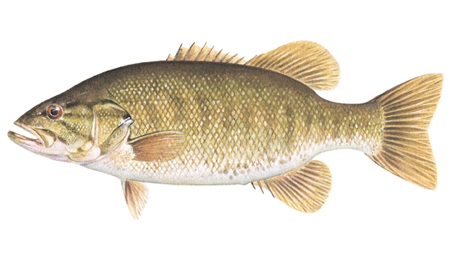The smallmouth bass is one of the largest in the Sunfish family (second only to the largemouth bass). The body shape is only slightly longer than deep and slightly thicker than the other Sunfish. They vary in color depending on water clarity but are usually golden brown to olive green with 8-15 vertical bars on the sides. Smallmouths may be confused with largemouth bass but offer the following distinctive differences: smallmouths have vertical bars on the sides, dark bars radiating from the eyes and the mouth reaches only as far back as the middle of the eye.
Common Names: Smallmouth bass, smallmouths, smallies, brown bass
Habitat
The traditional range of smallmouths was limited to the Great Lakes and the St. Lawrence but was extended with the expanse of the railways. Smallmouths were introduced into many of the waters throughout Southern and Northern Ontario. The current range extends southwards from Lake Nipigon. The preferred water temperature is around 21 ºC (70 ºF). Smallmouth bass are typically found in rocky areas, steep slopes and around fallen trees.
Spawning Patterns
Spawning occurs over a period of 6-10 days in late spring to early summer. The spawn is usually related to water temperatures around 13-20 ºC (55-68 ºF). Spawn sites are located in water less than 10 feet on sand to gravel bottoms. Nest sites are usually associated with some form of cover, usually fallen trees, boulders and occasionally dense vegetation. Eggs are dropped in five-second intervals and can last over a period of over two hours. Females can produce anywhere between 5,000 -14,000 eggs. A successful nest, however, may only produce about 2000 fry.
Diet
The most abundant food item is crayfish, making up anywhere between 60-90% of the diet. Fish and aquatic insects usually make up the remainder of the diet but such things as frogs, tadpoles and salamanders can also make up part of the diet.
Age and Size
Growth rates vary across the distribution depending on a variety of factors. Warmer waters tend to produce faster growing fish but small waters with large populations tend to be stunted. Maximum age in Ontario is suspected to be 15 – 18 years. It takes usually about 6 years for a bass to reach 30 cm (12”). Typical Ontario smallmouths are under three pounds and usually between 20-40 cm (8-15”), however, many trophy fish between 5 – 7 pounds are caught annually.
Fishing Tips
It is commonly argued that smallmouths are pound for pound the hardest fighting sport fish. In their arsenal are spectacular jumps that usually have the entire fish out of the water. The most exciting time to fish for smallmouths is in the early summer after spawning when they are still shallow. At this time they will hit almost anything with hooks. Fishing during calm evenings with top-water lures is some of the most exciting fishing available. Later in the year, smallmouths move to deeper rocky structures. Using deep diving crankbaits that imitate crayfish or an abundant fish species can be very effective at this time. Tube jigs are another popular bait for bass as are other crayfish imitating plastic baits. The most popular live baits are crayfish and leeches. During the late fall, fishing is tougher, but can produce the biggest fish of the year.
Fish illustration ©CURTIS ATWATER (www.natureartists.com/atwaterc.htm)










